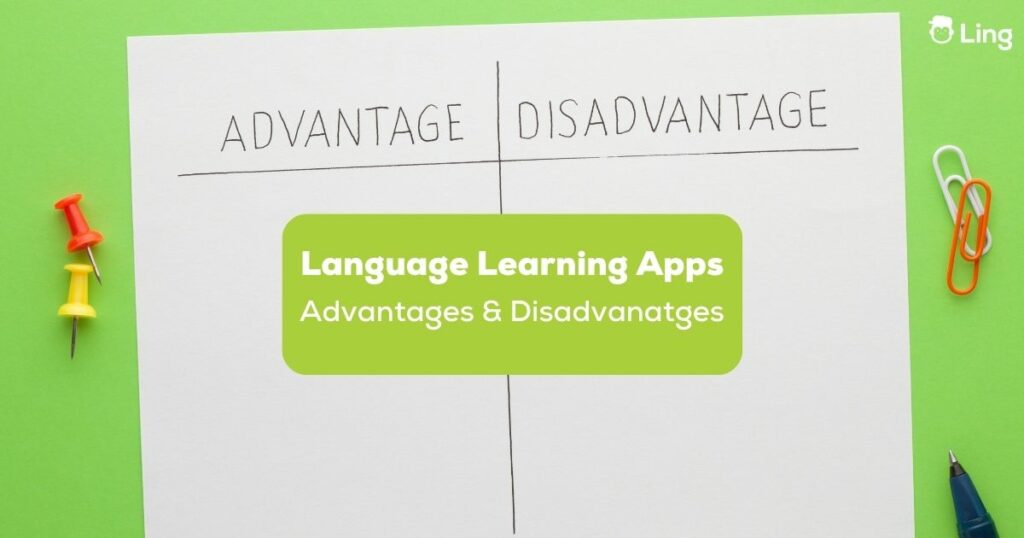Did you notice the huge boom in language learning post-Covid? Of course, we know the pandemic allowed people much more free time. Many started working from home and, with time to spare, also started taking quick lessons on language learning apps—advantages and disadvantages notwithstanding. In fact, over 1.5 billion people worldwide have turned to language learning apps like the Ling app to learn a new language and unlock the doors to new cultures and communication.
These handy tools, called language-learning apps, have revolutionized the way people approach learning a foreign language. Apps have made the entire process much more convenient and accessible than ever before. But are they really that advantageous compared to other resources?
To mull over this question, we are going to dive into the advantages and disadvantages of language-learning apps in this blog. We will find out why and how they’ve become so popular and how they can help or hinder your language-learning journey.
Current Scenario
Before we get into the pros and cons, let’s talk about why free language-learning apps have taken the world by storm. There are a few key reasons behind their popularity. Let’s take a look at them.
Accessibility: Language learning apps are the most convenient learning resources. They are like portable classrooms that fit right in your pocket. You can access them on your desktop, laptop, smartphone, or tablet anytime, anywhere. They are incredibly convenient for learners with busy schedules.
Interactive Learning: Many mobile apps offer interactive lessons, quizzes, and exercises that actively engage users. This interactivity keeps learners motivated and helps reinforce what they’ve learned. It also prevents boredom and helps the learner sustain their interest.
Personalization: These apps often use algorithms to tailor lessons to your skill level and learning pace. This personalized approach makes it easier for learners to stay engaged and not get bogged down by the rigidity of a preset lesson plan. This is a very effective way of ensuring visible progress.
Gamification: Many language learning apps incorporate gamification elements, turning the process into a fun and enjoyable experience. Earning points, competing with friends, and unlocking achievements can make learning feel like a game. And learning through fun and games is much more effective than simply reading and writing.
Language Variety: You’re not limited to just one language. These apps offer a wide range of languages to learn, from Spanish and French to less commonly taught languages like Nepali, Lao, Khmer, or Swahili.

Language Learning Apps Advantages And Disadvantages
Now that language-learning apps have become our trusty buddies in the quest for mastering new tongues, we are treated to convenience and accessibility like never before. But are they all sunshine and rainbows, or do they come with a few clouds? Let’s find out what are the language learning apps’ advantages and disadvantages.
Advantages
From the convenience of on-the-go learning to personalized lessons, these apps have reshaped how we acquire language skills. So, let’s explore the advantages of using language learning apps.
#1 Convenience
As mentioned earlier, the convenience of language learning apps is hard to beat. You can squeeze in a quick lesson during your daily commute or while waiting in line at the grocery store.
#2 Self-Paced Learning
Language learning apps allow you to progress at your own pace. If you need more time to master a particular concept, you can take it slow. Conversely, if you’re a fast learner, you can speed through lessons. Basically, you are free to set your own learning pace.
#3 Cost-Effective
Many such online applications offer free versions or trial periods, which is truly a godsend! They are a more affordable choice than traditional classes, as you save tons of money not hiring a tutor.
#4 Continuous Learning
With regular updates and fresh content, these apps encourage continuous learning. You can keep building your language skills over time without getting bored or feeling stuck in monotony.
#5 Community and Support
Language learning apps often come with a built-in community where you can connect with fellow learners and seek help or advice. This sense of community can keep you motivated and accountable.

Disadvantages
As with any technology, there are downsides to using apps to learn a new language, including the lack of real-life practice and the temptation to procrastinate. Let’s take stock of some cons of these apps.
#1 Lack Of Speaking Practice
Most apps focus on reading, writing, and listening skills, but they often fall short in providing opportunities for speaking practice. Fluency in a language requires regular speaking practice, which you might need to seek outside the app, among native speaker friends, or online forums.
#2 Limited Cultural Exposure
Language is intertwined with culture, and language learning apps may not provide enough cultural context. To fully understand and appreciate a language, it’s important to explore its culture, traditions, and customs.
#3 Overreliance On Technology
Relying solely on an app for language learning can be limiting. Human interaction, such as conversations with native speakers or immersion experiences, can provide a more well-rounded language education.
#4 Motivation Challenges
While gamification can be motivating, some learners may lose interest or motivation if they don’t see immediate progress. Learning a new language can be a long and challenging journey, and it’s important to stay committed and have self-discipline even when the novelty of the app wears off.
#5 Inaccurate Pronunciation
Some language learning apps may struggle with teaching correct pronunciation, especially for languages with complex phonetics. It’s essential to supplement your learning with resources that focus on pronunciation if this is a weakness.

6 Best Language Learning Apps For You
Now that we are aware of the pros and cons of using a language-learning app, let us take stock of the best three language apps that have worked hard to minimize the cons in this learning process.
1. Ling
Ling is your portable language school. Period. This gamified app offers over 60 languages to choose from, and you need not even be an English speaker to take these lessons. The most awesome thing about selecting a target language as quaint as Khmer or Swahili is that the Ling app offers well-researched and well-curated lessons recorded in native speaker voices, even for these languages.
The best part about Ling is that it is really affordable at $6.67/ month (for an annual subscription) when you take stock of the amazing number of features it offers you. For instance, Ling’s AI-powered chatbot ensures that you practice real-life conversations in your target language by learning vocabulary and phrases used by native speakers in their routine conversations.
Pricing
- Monthly:$14.99
- 6 Months:$39.99
- Yearly:$79.99 (7-day free trial available)
- Lifetime: $149.99
Transform Your Language Skills in a Week – Get the Ling app Today!
2. Duolingo
Yes, Duo has undoubtedly become everyone’s favorite green owl, all thanks to its cute antics. The app itself grew rapidly in the past few years due to its biggest selling point – all lessons offered free of cost. Moreover, its interface and audio quality also make it a joy to work with. It wouldn’t be wrong to say that Duolingo has almost all the ingredients to become the most well-rounded app for learning languages.
The only thing it misses out on is lessons on practicing grammar. You do get grammar tips every now and then or on making a mistake, but they are pretty random and appear inconsistently.
Pricing
- Free
- Super Duolingo: $9.99/ month (added features and some premium content)
3. Babbel
Babbel is another globally popular app for learning languages that has an impressive number of users. The lessons offered on Babbel are well-structured and beginner-friendly. The app’s audio exercises and speech recognition feature enhance pronunciation and listening skills.
However, it may lack depth for advanced learners. As an intermediate French learner, I found this quite concerning. Whenever this happens, the lack of motivation hits you enough to abandon the entire effort, which does not reflect well on the app.
Also, while the subscription is reasonably priced ($6.99/month with the annual subscription), the free content is limited. Still, Babbel does stand out for its focus on practical communication, though it may not suffice for those aiming for fluency or advanced proficiency.
Pricing
- Monthly: $16.99/month
- 3 Months: $38.97
- 6 Months: $59.94
- 12 Months: $83.88
- Lifetime: $299.99
4. LingoDeer
LingoDeer is a popular language-learning app that uses gamification and an interactive interface to teach. It is particularly effective for learning grammar and covers a wide range of topics. LingoDeer also has a special spaced repetition mode that helps you learn vocabulary more efficiently. The app allows you to track your weekly progress and earn 28 different achievements as you learn. Additionally, LingoDeer offers a variety of games and quizzes to test your knowledge and keep you engaged.
Pricing
- Monthly plan: $14.99
- Quarterly plan: $39.99
- Yearly plan: $79.99
- Lifetime:$159.99
5. Mango Languages
Mango Languages is a platform offering comprehensive lessons and materials designed for people interested in learning new languages. Its main goal is to allow learners to develop their language skills while gaining cultural awareness. The app’s easy-to-use interface and interactive approach have made it popular among language learners. This app is based on a conversation-driven approach that strengthens the fundamental components of communication: grammar, vocabulary, culture, and pronunciation.
Pricing
- Single language subscription (access to 1 language): $7.99/month (Monthly plan) and $6.77/ month (Annual- plan).
- All languages subscription (access to 70+ languages): $17.99/month (Monthly plan) and $14.99/ month (Annual- plan).
6. Memrise
Memrise is another popular app known for its focus on flashcards. With a wide range of flashcards, this app is incredibly effective at helping users memorize specific aspects of their target language. Unlike gamified apps, Memrise may not be as entertaining, but it does offer a user-friendly interface that is easy to navigate. Learners are able to create their own flashcards or use pre-existing decks. The app is ideal for short study/review sessions, making it a flexible and convenient tool for learning any language.
Pricing
- Monthly subscription: $14.99
- Yearly subscription: $89.99
- Lifetime membership: $199.99
Language Learning With Ling
Choosing Ling to kickstart your language-learning journey could be the turning point in your education. That’s because Ling aims to address all the aspects of language skills through its engaging features. From tracing alphabets on your screen with your fingers to understand the basic letters to creating your own conversational phrases, Ling offers you a completely customizable learning experience. Not sure? Take advantage of the 7-day trial to get a taste of all that Ling has to offer.
So, don’t wait any longer. Head straight to the App Store or Play Store and start your Ling trial period now!

































































